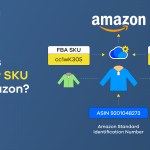The Stock-Keeping-Unit, or SKU, is an identifying label assigned to each product your ecommerce business acquires and sells. As such, SKUs play several crucial roles in online retail. Materials from other businesses come with their existing SKUs, but you are free to (and should) create your unique SKUs for the products you sell.
SKUs are used to:
- Identify particular products in your inventory and stock.
- Give third-party marketplaces and logistics providers a way to correctly identify your products.
- Link your merchandise to both its internal and external catalog listings.
- Help your fulfillment team pick, pack, and ship the correct merchandise to customers.
As valuable as SKUs are for organizing and processing orders, they are also vital to measuring both the growth and evolution of your ecommerce brand. Much of the ebb and flow of your omnichannel ecommerce business can be tracked alongside the life cycles of your SKUs. Every SKU follows a predictable pattern from creation to its eventual end of life.
Knowing where a product is in this timeline can help you make the decisions to optimize everything from production to marketing. Conversely, neglecting the telltale signs of an SKU transitioning through its life cycle could negatively impact your bottom line.
SKU Creation
Technically, a SKU can be any unique combination of letters and numbers you choose. That said, a more purposeful SKU design could be used to help keep your business and inventory more organized.
Some considerations when deciding on a SKU format include:
Length
As a rule, SKUs should never exceed 16 characters. In most cases, 8-10 characters will work just fine.
Purposeful Characters
Rather than choosing random characters (SKUs typically include digits 0-9 and letters A-Z), consider being more deliberate in your SKU creation. Some SKUs may contain specific abbreviations that are relevant to your products.
For example, S, M, and L could indicate size variations for a particular product. ‘V1’ and ‘V2’ could be used to distinguish between different versions. In some special cases, codes can even be created to link products to identifiers like lot numbers or manufacturing dates.
Readability
If an SKU is misread, it can cause costly errors like misplaced inventory or fulfillment mistakes. Considerations like the use of hyphens or underscores to break up longer strings of characters or deliberate avoidance of easily confused character pairs like ‘1’ and ‘l’ or ‘0’ and ‘O’ can make your SKUs more readable and help avoid confusion.
Different Types of SKUs
In some cases, the SKUs you create may not exactly match those assigned by third-party partners. Some marketplaces and fulfillment companies may assign unique identifiers for your products to comply with their internal record-keeping procedures and/or avoid confusion with products from other brands.
In some cases, it may be ideal to accept a merchant SKU as your own to avoid confusion and redundancy. There are also specialty SKUs that you may create within your own brand. For example, Descartes Sellercloud allows you to create Shadow SKUs, which are secondary product SKUs assigned to products from the same inventory that allow you to do things like A/B test catalog listings, sell products across multiple categories, and sell the same product with unique names and images.
Bundled and kitted merchandise can be assigned unique SKUs as well. This allows you to list multiple products as a singular catalog item while allowing your fulfillment team to pick, pack, and ship the combination from your inventory, either piecemeal or as a prepackaged set.
Tracking SKU Growth
Once a product has been assigned an SKU, you can track a number of different product characteristics. Some elements are functional, like generating individual order summaries and invoices to share with customers or the picking and packing status of orders being fulfilled by your warehouse team.
Others are big-picture metrics that allow you to assess the performance of your products across your brand and the places where you sell them. The latter must be a cornerstone of your ability to make data-driven decisions about the short- and long-term value of your SKUs.
Ideally, you want every SKU to sell well and generate substantial profits for your ecommerce business. In reality, not every SKU can be your top performer. If you are like most brands, you are likely to have anywhere from 10-30% of your SKUs generating 70-90% of your profits. The remainder are typically less popular, more niche, or seasonal products.
When a new SKU is added to your brand’s offerings, you may not immediately know whether it will be a hit with customers. As such, you need to be tracking how your SKU is performing.
Some particular SKU-based metrics to watch include:
- Profit & Loss (P&L).
- Inventory Turnover Rate (ITR).
- Channel-based performance.
- YOY (Year-Over-Year) seasonal performance.
An omnichannel ecommerce management platform like Descartes Sellercloud and our WMS (Warehouse Management System) platform, Skustack, gives you the power to monitor and track these figures over the life cycle of your SKUs. Even if a new SKU doesn’t achieve brand-defining success, it can still be a viable offering to keep in stock and listed on the channels where you sell.
Ultimately, when monitoring SKU growth, you are looking for improvement and profitability over time. As this continues to trend upwards, you can be confident that your SKU is still in the emerging stages of its life cycle and will remain viable in the short term.

SKU Maturity and Decline
As the curves of the metrics above begin to flatten, this may indicate that an SKU has entered its next stage. This is sometimes referred to as ‘product maturity.’ At this point, your production and sales volume should be at their absolute peak for the given SKU.
You may prolong this period by reducing production costs (which the inventory turnover rate may justify) and/or exploring new secondary markets. Inevitably, however, once a product reaches maturity, it is unlikely to undergo a resurgence.
As sales and profits for an SKU decline compared to your historical SKU data and other products, it becomes time to seriously consider said SKU’s remaining value to your business and brand. Sometimes, it may not have the relevance or profitability to remain in your catalog.
This type of decline could be caused by several factors, including:
- The SKU faces increased competition in the marketplace.
- You have exhausted new venues to market and sell the product.
- The SKU is becoming obsolete due to advances in technology.
- A new version or iteration of the product is cannibalizing the SKU’s sales.
- The SKU faces a general decline in public interest.
A decline caused by these factors may not justify abandoning an SKU, but it should raise a flag that the time for that difficult decision is likely approaching. Yet, during the decline phase, there is still money to be made. The fact that production has likely already been optimized and is at its most efficient price could allow additional profits to be eked out, even as marketplace interest starts to dry up.
When to Phase Out a SKU
No matter the cause, when maintaining an SKU, with all the inventory space, marketing, and general attention that it requires, outpaces the product’s value to your bottom line, it is usually time to move toward the final stage of the SKU’s life cycle.
This involves a series of moves that commonly include:
- Removing dead stock from your warehouse through sale or destruction.
- Delisting the SKU from your website and marketplace channels.
- Issuing orders to retrieve or destroy excess inventory held by third-party partners.
- Reallocating production to more viable SKUs or terminating relevant production agreements.
- Reallocating marketing efforts toward new or existing SKUs
Failure to recognize this inflection point can prove costly for many reasons. It is foolish to continue dedicating warehouse space and carrying costs to SKUs that are not generating a return on investment. The resulting dead stock and catalog bloat can detract from the value of the rest of your products and reduce your overall efficiency in marketing and fulfilling orders for your profitable SKUs.
The Descartes Sellercloud product suite is perfectly suited to supporting your brand’s SKUs throughout their entire life cycle. Our over 350 integrations with industry-leading omnichannel ecommerce partners can put you in the position to maximize the value of your products and extend their profitability as far as possible.
Moreover, our cloud-based platform makes creating and tracking your SKUs simple and intuitive. That means you can easily access the information you need to make data-based decisions and maximize the potential of every SKU you create.
Contact us for a free demo and see how Sellercloud is the partner you need to take your ecommerce business to the next level.




